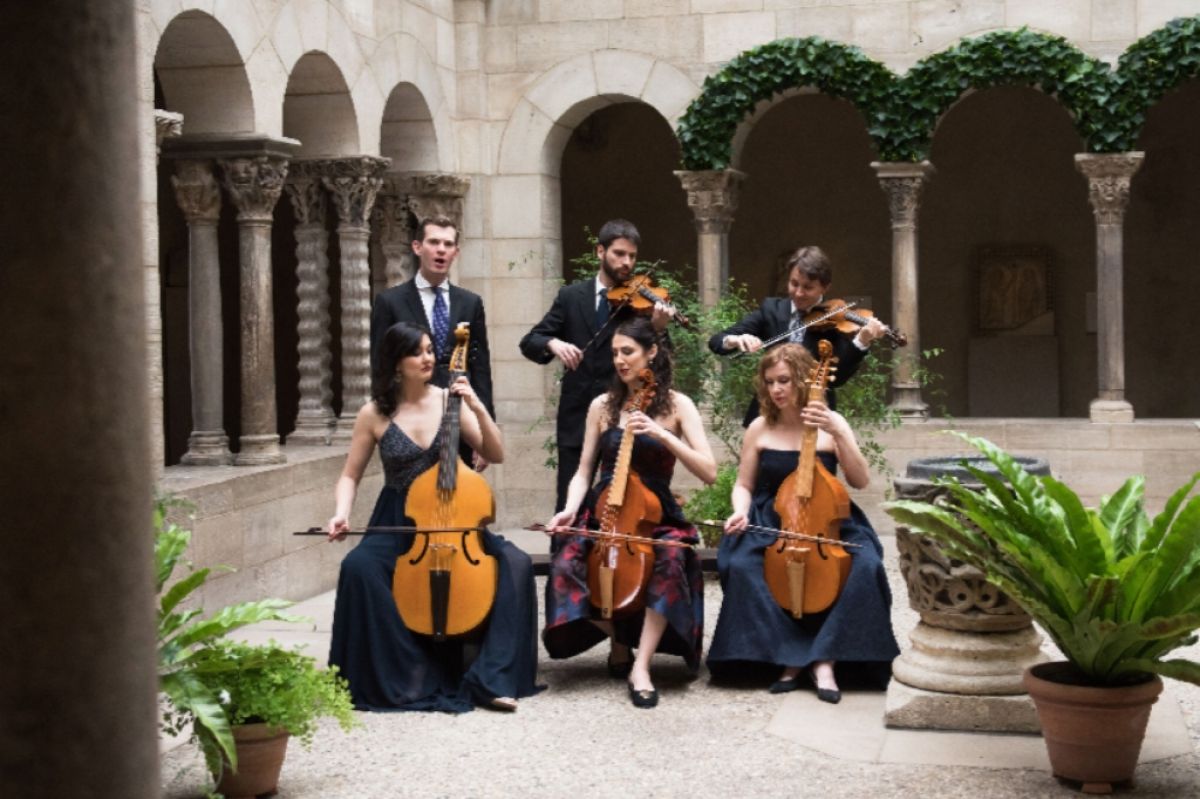Hello, and welcome to Harmonia Uncut, the podcast that brings you modern performances of old music. I’m Wendy Gillespie, and we’re going to New York City, specifically the Baruch Performing Arts Center on 25th St. between Lexington and Third Ave. The date is September 14, 2017, and we’re going to listen in on a performance by the ensemble intriguingly named Sonnambula. Their 2017-18 series at Baruch was called “Women’s Voices!” and aimed to give voice to women composers of the early modern period. This first concert on the series featured Elisabeth Jacquet de la Guerre, and Sonnambula have very kindly shared selections from the concert of music by some of Jacquet’s contemporaries that they feel was very much influenced by her work.
The instrumentation of 2 violins, tenor viol, two bass viols and harpsichord is one of several possible ensembles perfect for five-part French music of the seventeenth century. Let’s get a taste of this combination of instruments from a Symphonie by Henri Dumont that was published in 1652:
MUSIC
That was a Symphonie by Henri Dumont - and I promise it was a whole symphonie, but of course the word did not mean the same thing in the C17 as it did in the time of Haydn. The root of the symphony implies a “harmony of sound,” and from about the 1590s it was used to name a short instrumental piece for several players, often a prelude or interlude.
Let’s turn now to instrumental extracts from the comedy-ballet Le Bourgeois Gentilhomme by Jean-Baptiste Lully. First, reflect on the title: in the France of Moliere’s day, a "gentleman" was by definition nobly born, thus there could be no such thing as a bourgeois gentleman, so the title of his comedy is a purposeful oxymoron; the plot is full of silliness, not all of it politically correct by today’s standards. It was first performed in front of Louis XIV himself in 1670 with an all-star cast of musicians and dancers, so let’s fantasize an amusing ballet as we hear first the Entry of two Scaramouches, two Trivelins, and a Harlequin representing an evening at the commedia dell’arte. That will be followed by a March for a “Turkish” Ceremony; and finally, the Chaconne for the same five commedia characters to reprise their dancing and comedic skills.
MUSIC
Sonnambula gets down with music of Jean-Baptiste Lully from the comedy-ballet Le Bourgeois Gentilhomme.
Since we’re in C17 France, how about a bit of splendour? Let’s turn our thoughts to imagine the marriage of Louis XIII in 1615 to his second cousin Anne of Austria, the daughter of Philip III of Spain. Louis was all of 14 years old, and had already been king for 5 years, after all, so no doubt he was up for a celebration.
MUSIC
Sonnambula played an anonymous Pavane for the marriage of Louis XIII, likely used to move people who were very, very dressed up with grace and dignity from one place to another. (I admit, I’m picturing the 14 year old…)
Finally, a Chaconne from the end of Scene III of Les Fontaines de Versailles, whose music was composed by the 26-year- old Michel-Richard de Lalande one year after Louis XIV moved the French court to Versailles. Oh yes, and Louis had also given a new post to Lalande. Les Fontaines de Versailles celebrates the new era with a meeting of the deities depicted in sculpture around the many fountains adorning the chateau’s gardens. I’m picturing statues that magically come to life and take part in this stately chaconne doing beautiful baroque dance steps:
MUSIC
Michel-Richard de Lalande’s Chaconne from Les fontaines de Versailles. The ensemble Sonnambula, directed by tenor viol player Elisabeth Weinfield, includes violinists Jude Ziliak and Toma Iliev; bass viol players Amy Domingues and Shirley Hunt, and harpsichordist James Kennerly. Sonnambula’s mission is to explore unknown repertory “with the lush sound of the viol at its core” with an emphasis on neglected masterpieces, and we look forward to hearing a lot more from this ensemble. Many thanks to artistic director Elisabeth Weinfield for sharing this wonderful performance that conjured so many visions of a world full of grace, splendour, and beauty.
We’re always interested in hearing your thoughts about anything you’ve heard on this podcast. You can find Harmonia on Facebook, or leave a comment or question any time by visiting harmonia early music dot org. This has been Harmonia Uncut, and I’m Wendy Gillepsie, stay safe and thanks for joining me!










